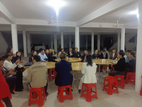Built in 1930, an old church in Zhongshanlu or Zhongshan Road, Nanning, Guangxi, has been listed as a reconstruction project of the city's old area. However, one scholar named Chen Guoyan from the China Folklore Society appeals to retain this cultural heritage that should be cherished.
Born and grown up in Zhongshanlu, Chen is familiar with the church and its history. His grandfather pastored in the church's parish with some British missionaries from 1924 and continued to serve in the church after 1949. Even at an old age, the servant volunteered in the church until he passed away.
The history of the church can be traced back to 1913 when the founder, Dr. Lechmere Cliff, a British missionary from Emmanuel Medical Mission, purchased five houses where the city's first hospital, Daoji Hospital, was situated. Meanwhile, he preached the gospel and adopted many abandoned babies, loving them and as a result, he was respected by the locals. In 1942, he gave the hospital and his mission work freely to the Bible Churchmen's Missionary Society (BCMS), which was set up in 1922. One year later, he returned to Britain and the society sent a pastor and a doctor to continue his work. From 1926 to 1930, some British missionaries came to the place and engaged in medical work and evangelism.
In 1930, the society constructed the brick and wood three-story church located north of the hospital. Named Salvation Church, the church had Gothic stained glass windows. It was recorded that the church attendance reached more than 140 when it was opened, the highest among the other Christian and Catholics churches in Nanning in the period.
The church helped over 200 refugees in 1939 when the city was occupied by the Japanese army, according to the city's historical records. A decade later, it established a primary school in the same area. Three years later, the church turned the leadership of the hospital and school over to the local government. In 1966, the church activity was ceased due to historical reasons. It was then reopened and renovated in 1980. The reconstruction lasted for one year and the church was converted into a brick-and-concrete building with two stories before it was reopened.
In 2006, the church had a congregation of more than 2000 people, holding services on Saturdays and Sundays. Three years later, it conducted three services every week. Owning other gatherings, the church also hosts special worship on Easter and Christmas.
Translated by Karen Luo












